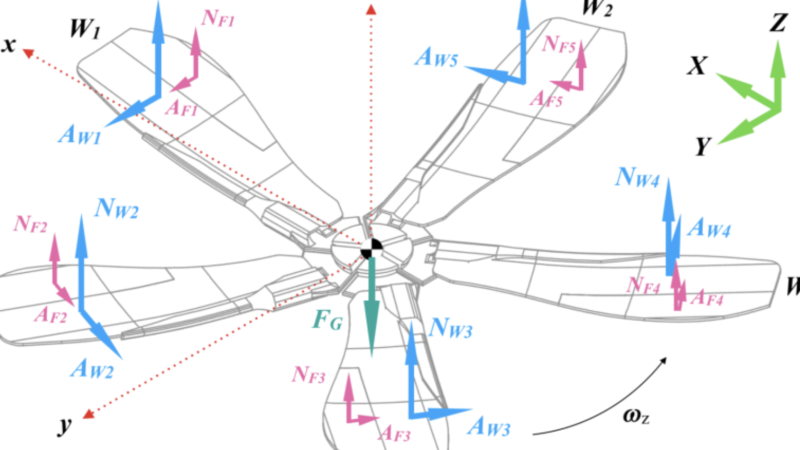Researchers from the Singapore University of Technology and Design (SUTD) recently released a video showing their nature-inspired drone that is capable of breaking out into five separate smaller drones. The drones each have auto-rotating wings that slow their rate of descent, similar to seed pods from a maple tree. Due to their design, the drones are only made to be used for a one-way trip, with the five components each carrying a separate payload. The drones are designed to detach within a specified distance from their destination, allow the collective body to safely spiral downwards towards land.
In their paper published on the same subject, the researchers discuss how they optimized the balsa wood wings with servos, a LiPo battery, and a receiver attached to a 3D-printed body. Four are equipped with just these components, while the fifth also holds a 3-axis magnetometer, a Teensy 3.5 board, a GPS module, and a Pixracer controller.
They experimented with several motion capture setups and free-flight drop tests to verify their simulations on the models for the drones. Apart from simply detaching, they are also designed to cater to different mission profiles based on the environment they are dropped in.
We’ll admit that the implementation and design of the drones does seem fairly dystopian, especially when you wonder what could possibly be the payloads these drones are designed to carry. But in terms of nature-inspired robotics, the maple seed pod idea is pretty interesting.
[Thanks to Itay for the tip!]
















Great design for cluster bombs
was about to say that…
Why would you want bombs that fall slowly? Seems like an awful design for cluster bombs
because in this way your cheap electronic has more time to measure the altitude where it needed to detonate the payload for the maximum damage…
That is what the RF fuses (Proximity or RADAR) have done in artillery shells since the 1940’s. At 4000 feet per second they only go 0.05 inches per microsecond (1.2mm).
there’s an entire class of weapons called “loitering ammunition”, which does exactly that…parachutes, suicide drones, some use rockets…
The idea is to give it time to find a target using very simple sensors.
NBC – nuclear, biological, chemical. All can benefit from mixing with air.
Even petroleum gasoline can mix with air for a more potent explosion.
Burning all the oxygen in a region can be used to fight fires, or people.
My first thought too. Extended loiter time and active manoeuvring for a CBU-97 like submunition dispenser.
on a more cheerful note than the comment above,
I can see this for emergency supply drops right off..
..emergency supply of TNT to a large area.
more like some much fancier explosives in a shaped charge…you don’t use cluster bombs to kill people, but things (many times people happen to be operating said things at the time, but they are not the primary target, the machine is)
LOL
It does seem like parachute tech is already optimised for emergency supply drops.
NASA did a design like this in the 1990s to carry a scanning camera for a planetary mission, ostensibly Mars. It would create panoramic pictures as it rotated during descent (still an interesting idea, particularly given the improvement in imaging capability).
The best, and most memorable part was its name – the winged seeds are called “samara”, and so it was the “Samara Camera”
Falling LIDAR scanner! Can be used for ultrafast area recon. Make it small enough and it wouldn’t even be noticed!